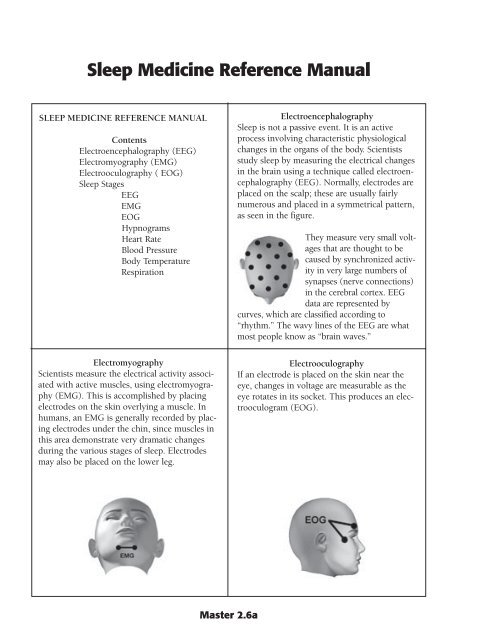Biological - NIH Office of Science Education - National Institutes of ...
Biological - NIH Office of Science Education - National Institutes of ...
Biological - NIH Office of Science Education - National Institutes of ...
You also want an ePaper? Increase the reach of your titles
YUMPU automatically turns print PDFs into web optimized ePapers that Google loves.
Sleep Medicine Reference Manual<br />
SLEEP MEDICINE REFERENCE MANUAL<br />
Contents<br />
Electroencephalography (EEG)<br />
Electromyography (EMG)<br />
Electrooculography ( EOG)<br />
Sleep Stages<br />
EEG<br />
EMG<br />
EOG<br />
Hypnograms<br />
Heart Rate<br />
Blood Pressure<br />
Body Temperature<br />
Respiration<br />
Electromyography<br />
Scientists measure the electrical activity associated<br />
with active muscles, using electromyography<br />
(EMG). This is accomplished by placing<br />
electrodes on the skin overlying a muscle. In<br />
humans, an EMG is generally recorded by placing<br />
electrodes under the chin, since muscles in<br />
this area demonstrate very dramatic changes<br />
during the various stages <strong>of</strong> sleep. Electrodes<br />
may also be placed on the lower leg.<br />
Electroencephalography<br />
Sleep is not a passive event. It is an active<br />
process involving characteristic physiological<br />
changes in the organs <strong>of</strong> the body. Scientists<br />
study sleep by measuring the electrical changes<br />
in the brain using a technique called electroencephalography<br />
(EEG). Normally, electrodes are<br />
placed on the scalp; these are usually fairly<br />
numerous and placed in a symmetrical pattern,<br />
as seen in the figure.<br />
They measure very small voltages<br />
that are thought to be<br />
caused by synchronized activity<br />
in very large numbers <strong>of</strong><br />
synapses (nerve connections)<br />
in the cerebral cortex. EEG<br />
data are represented by<br />
curves, which are classified according to<br />
“rhythm.” The wavy lines <strong>of</strong> the EEG are what<br />
most people know as “brain waves.”<br />
Electrooculography<br />
If an electrode is placed on the skin near the<br />
eye, changes in voltage are measurable as the<br />
eye rotates in its socket. This produces an electrooculogram<br />
(EOG).<br />
Master 2.6a

















